#Cross of Iron 1977
Explore tagged Tumblr posts
Text
Stransky/Steiner fancam
#james coburn#maximilian schell#quentin tarantino rly said yeah two rounds of this movie and somethn french. thanks. for inglori*us bas*erds#cross of iron 1977
3 notes
·
View notes
Text
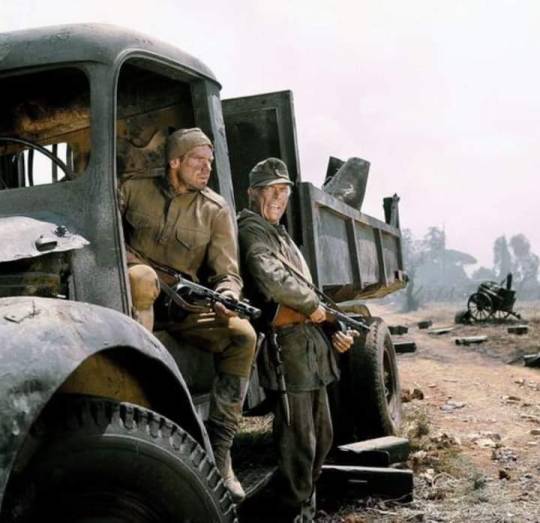
30 notes
·
View notes
Text

CROSS OF IRON. Directed by Sam Peckinpah, 1977.
#movie#war#world war ii#germany#classic#sam peckinpah#james coburn#cross of iron#maximilian schell#1977#david warner#epic war
8 notes
·
View notes
Text
youtube
CROSS OF IRON (1977) Grade: B
James Coburn was cold, great actor. Sam Peckinpah film so the action gritty and good, especially the sound. It had to win something for 1977? It was awesome.
#Sam Peckinpah#1977#B#Cross of Iron#War Films#Drama Films#James Coburn#Maximilian Schell#David Warner#Soldiers#James Mason#Vadim Glowna#Klaus Löwitsch#Roger Fritz#Véronique Vendell#Arthur Brauss#Demeter Bitenc#Russia#Youtube
4 notes
·
View notes
Text










Cross of Iron (1977) Sam Peckinpah
June 3rd 2024
#cross of iron#1977#sam peckinpah#james coburn#maximilian schell#james mason#david warner#Klaus Löwitsch#roger fritz#senta berger#sargeant steiner
5 notes
·
View notes
Text
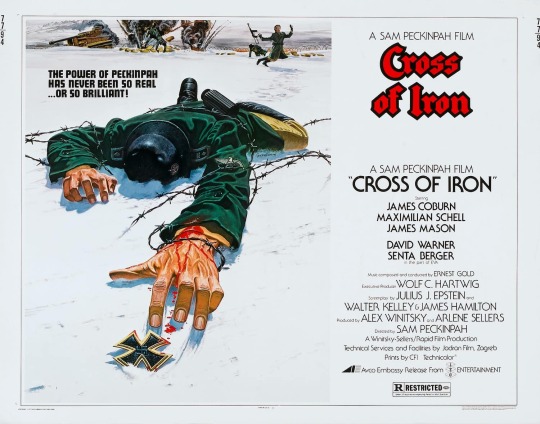
Cross of Iron (1977). Artwork by Robert Tanenbaum.
29 notes
·
View notes
Text
Bulgarian Music in Studio Ghibli films
”Myth has it that Orpheus was born in what is now Bulgaria. It seemed to be fact, not myth, that his daughters are still singing there”
These words were written by the New York Times in the remote 1963 — the year in which the largest Bulgarian folk ensemble crossed the Iron Curtain to conquer an entire continent with its cosmic art.
The 1975 release of Le Mystère des Voix Bulgares, a compilation album of modern arrangements of Bulgarian folk songs, further popularized Bulgarian music, and in 1977, a vinyl record featuring the folk song “Izlel ye Delyo Haydutin” (Eng: Come out rebel Delyo) began its journey aboard the Voyager 1 and Voyager 2 spacecrafts.
From this point on popularity from the West spread to the East, and Bulgarian folk music made it to the entertainment industry, including legendary Japanese anime films, like the cult cyberpunk “Ghost in the Shell” or the heartwarming Studio Ghibli features.
In this short article I write about two occasions of Bulgarian music playing in Studio Ghibli’s films.
The record that inspired the creation of “Only Yesterday”
“Only Yesterday” is a 1991 Japanese animated drama film written and directed by Isao Takahata, based on the 1982 manga of the same title by Hotaru Okamoto and Yuko Tone. Set in rural Japan, the film draws parallels with the peasant lifestyle present in Eastern Europe.
The original work is a compilation of short stories about 11-year-old Taeko’s daily life in 1966. Director Takahata had a hard time making it into a movie since the manga, told in the form of a memoir, has no plot to hold a feature. Together with producer Toshio Suzuki, they came up with the solution of bringing the narrator of the story, adult Taeko, into the movie. But there is a curious anecdote about how this idea came to mind.
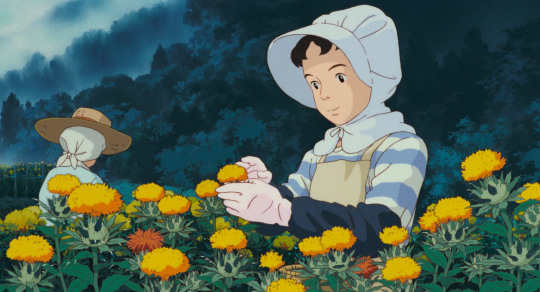
Taeko picks safflower as the Bulgarian song “Malka moma dvori mete” plays in the background. © Studio Ghibli
In a 2021 interview with students from Sofia University St. Kliment Ohridski, producer Suzuki recounts how a record of Bulgarian songs performed by the children choir “Bodra Smyana”, introduced to him by director Takahata, inspired the creation of the movie. Moved by the cosmic voices of the children, they decided to make “Only Yesterday” a musical. He also recalls what a tiring process it was to acquire the rights to the music, but if you’ve seen the movie, I am sure you will agree that it was worth it; the haunting, beautiful songs with the pastoral images of farmers picking flowers contribute to one of the greatest scenes created in cinema.
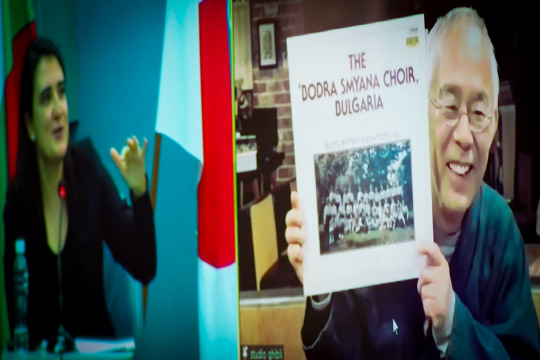
Producer Suzuki showing the record that inspired the creation of ”Only Yesterday”. Source: Studio Ghibli’s Twitter
In “Only Yesterday”, we can hear two songs from the album Bulgarian Polyphony I by Philip Koutev Ensemble. The upbeat “Dilmano Dilbero” [Eng. beautiful Dilmana] sets a happy mood as the protagonist gets changed and ready to go on the field. As the scene shifts and Taeko starts narrating a sad story about the girls in the past picking safflower with their bare hands, the song and mood shift as well.
While the first song has a fast rhythm, with lyrics about pepper planting that can also be interpreted figuratively, the second one, “Malka Moma Dvori Mete” [Eng., a little girl sweeps the yard], is a ballad about a young girl who is forced into marriage but has never known true love.
Both compositions sing about life-cycle events like marriage and the regular coming of the harvests, with lyrics perfectly fitting the setting and plot of the movie, which makes me wonder if the filmmakers chose them by chance or if they had someone translate the words.
Bulgarian Cosmic Voices Enchanting Howl
“Howl’s Moving Castle” is a 2004 Japanese animated fantasy film written and directed by Hayao Miyazaki, loosely based on the 1986 novel of the same name by British author Diana Wynne Jones. Set in a fictional kingdom the movie draws inspiration from various places in Europe. One of them being Bulgaria.
The story focuses on a young girl, named Sophie, magically transformed into an old woman, and a self-confident but emotionally unstable young wizard, Howl, living in a magical moving castle.
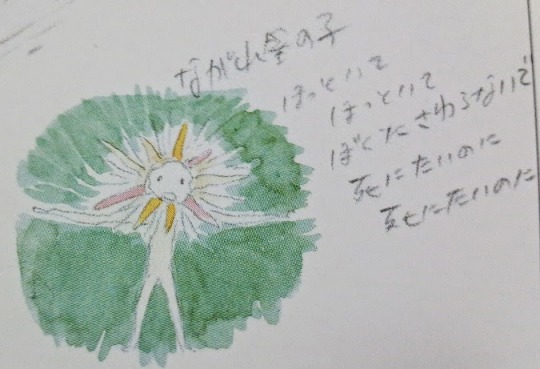
A sketch of a Star Child. Source: The Art of Howl’s Moving Castle
If you’ve seen the movie, you surely remember the scene when Madame Suliman ambushes Howl and tries to strip him of his magic powers. Star Children encircle him and his companions; their shadows grow big, dark and intimidating. They start dancing and chanting unintelligible magic words and are almost successful in their devilish act.
This scene, together with the music played in the background, have been a favourite of many fans of the film. Some even recount it giving them nightmares when they were children.
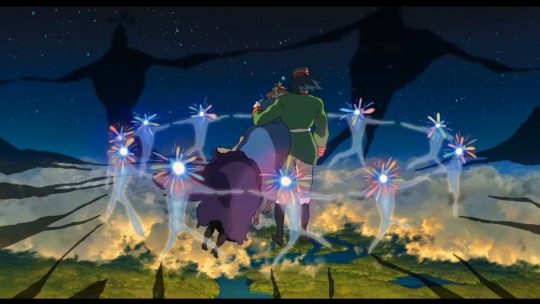
Star Children encircle Howl in an attempt to strip him of his magic powers. © Studio Ghibli
It turns out, however, that these aren’t any incantations, but the lyrics of a folk song. In Bulgarian. And a love song! Contrary to popular belief, the lyrics have nothing to do with magic and are actually about a boy taking his sweetheart, Dona, to the market to buy her new clothes. The excerpt used in the movie is very short and a bit altered from the original, but the words used go like this: Trendafilcheto, kalafercheto, Done mamino, translated as “the rose, the costmary, my darling Dona”.
I am planing a follow up article where I will post the translated lyrics together with a brief explanation on how they are related to the movies.
If you want to comment on or add something, I would love to hear!
Source
#studio ghibli#only yesterday#howls moving castle#Le Mystère des Voix Bulgares#bulgarian folklore#bulgaria#toshio suzuki#hayao miyazaki#isao takahata#bulgarian music in ghibli films#the boy and the heron#スタジオジブリ#ブルガリア#おもひでぽろぽろ#ハウルの動く城#宮崎駿#高畑勲#鈴木敏夫#bulgarian music
692 notes
·
View notes
Text



SIMPLE AND SWEET
(kissing michael headcanons) | 748 words
WARNINGS: mature themes , sweetness , describing kissing , genderless reader!
[1977]
you’re family friends, maybe
grown up around each other
…the type to have gotten teased all the time because everyone knew you liked him. even your mother noticed you’d gotten shyer around all the brothers, but especially, especially michael
oh he’d gotten so tall and fine…
you remarked every new thing about him when he’d gotten back from tour. his face forming strong, his body full of energy and tambour, his spirit like a drumbeat that kept time all through the night
and despite all that change, he was still like the sweet boy you’d grown to blush under the gaze of.
the jacksons always had these family parties and whenever you could, you’d often need to find a quiet place for the two of you to occupy within the mighty full house
a lot of the time you’d settle in the backseat of your daddy’s car and talk. it was always unlocked and in the shade of the street. you appreciated the privacy.
he’d tell you stories for what felt like hours, your faces incredibly close in the darkness. sight dodging from lips to jaw to the light still left in your eyes.
you remembered them all.
but, most notably, you remember learning how to kiss.
have you ever kissed before? michael’s hands stayed crossed in his lap. though you couldn’t see them, you just knew.
you shook your head.
never? he giggled, as if he had any more experience than you did. and his gaze fell, thoughts trailing around in his mind: do you wanna try?
leaning into him, the leather of the seats creaking, you found his lips in the shadows. he inhaled sharply.
it started with some kisses on closed mouths. one. two. three. your hearts racing, you pull back to breathe.
was that okay?
yeah…
your hands would find his cheeks and you’d kiss. pillowy soft and slow like pouring molasses, not quite sure you were doing it right, but you knew you liked it. the way your lips felt. mouths opening and closing, sighing into each other.
your other senses washed over you then.
your lips quietly smacking with each kiss
the noise from his house echoing faintly behind; floating from a world somehow ages and ages away from where you were then
your fingers run along his full cheekbones, glide along the little bumps and ridges in his skin. he’d take your hand, sensitivities arising, and guide it over to his shoulder, the fabric there starched and ironed.
his hands spread, with elongated fingers, like butter along your blouse.
and his lips, smooth like satin, tasted of mint balm. sometimes, you felt bold enough to try his neck. kissing over stubble and the sting of sweat.
your nose filled with the purity of shea, boys’ nerves, and sweet, sweet spritzes of his brother’s cologne trapped inside the threads of his clothes.
he welcomed it happily, your devouring love.
soon you practically begged for parties. any chance you got to kiss michael, you’d take
you’d be gone for a long while
kissing, hands all over each other, sweet hums and gusts of breath coming quick enough to fog the windows
you’re like heaven, baby he’d whisper, his lips rubbing against the lobe of your ear. probably something he heard one of his brothers say, but it sent shivers right through you all the same
walking back to the house, you’d try not to steal kisses, but the addiction was rampant in you by now. let you tell it, you needed it to live.
a jackson would come stumbling out of the party for air or a smoke sneering, ooooo mike what were yall doin’ out here……..
we were just talkin’ he’d blush, clasping your hand tight like he’d gotten caught with it in the cookie jar
you didn’t have the width to string together an alibi. not with his lips still lingering all over, as real and heavy as the pulse in your veins
so you simply smiled down at your feet, squeezing his culprit fingers in tandem
as you get a bit older, you find your kisses to be quite serendipitous. harmonious with each other.
standing outside your place, you kiss each other nice and long, holding both his hands by your sides in case he might try to slip away too quickly.
looking up at him, his eyes flutter open, the regained breath from his lips reminding him he was in fact down on earth.
tilting your head, you smile. see you tonight?
that same boyish grin would find you, smiling back. yeah…
simple and sweet.
#giving my 77 baby some love#this was part one TEEHEE#anyway hope you enjoyyyy#michael jackson x reader#michael jackson imagine#applehead#moonwalker#michael jackson oneshot#2222gospel
75 notes
·
View notes
Text


Inbound at Rondout
An inbound Milwaukee Road commuter train has just joined the double track main line, coming in off the Fox Lake Branch. The train is seen here passing the well-known tower at Rondout and will now head toward Chicago Union Station on the high iron.
At the time of this image, the Elgin, Joliet & Eastern crossed here at the tower; that line would become part of Canadian National. The Milwaukee Road itself will be folded into the Canadian Pacific. The commuter train will become part of Metra, with the locomotive here (an F40C) already being funded by local transit agencies to help out the (by that time) faltering Milwaukee Road.
I’ve included the going away shot to show the F40C more clearly. EMD built only fifteen of these units, but its development led to the successful F40PH, of which there would be hundreds.
Two images by Richard Koenig; taken October 9th 1977.
#railroadhistory#railwayhistory#milwaukeeroad#commutertrain#rondoutillinois#roundoutil#rondout#f40c#ejande#foxlakebranch#canadianpacific
39 notes
·
View notes
Text
CROSS OF IRON (Peckinpah, 1977)
19 notes
·
View notes
Text
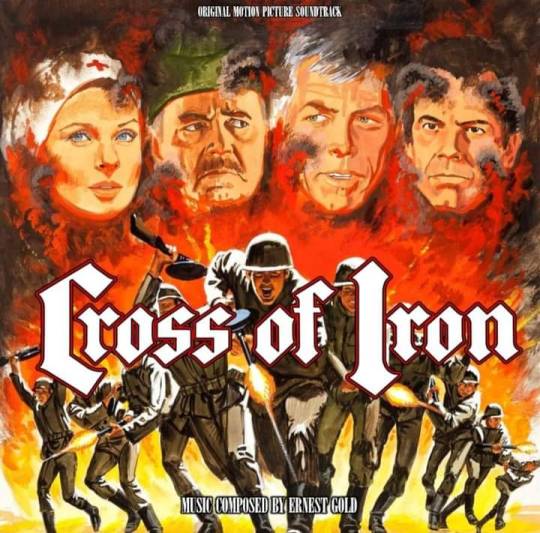
7 notes
·
View notes
Text
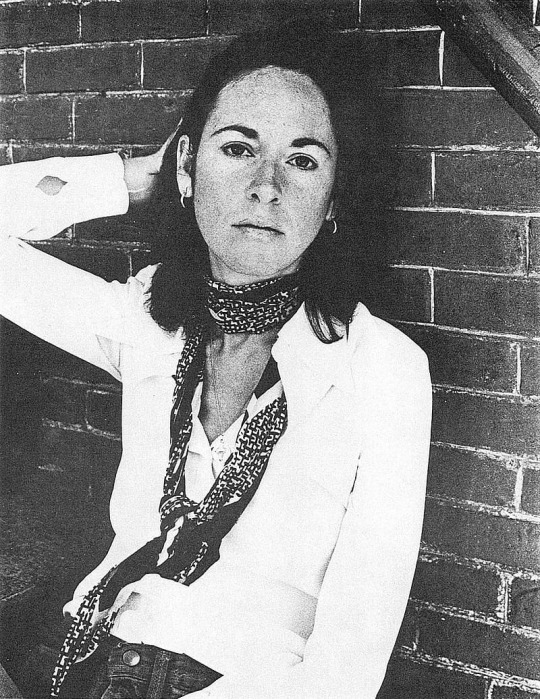
Louise Glück circa 1977
* * * *
"It is true that there is lack of beauty in the world. It's also true I'm not the one to give it back. There's no candor either, but I can be useful there.
I am Working, even though I'm quiet.
The island
misery of the world pull us closer, an alley with rows of trees; we are
fellas here no talking, each one with his thoughts
behind the trees, the gates of iron houses, the shutters closed
in rooms somehow empty, abandoned,
as if it were the duty from the artist create hope, but from what? from what?
The word itself it's false, an instrument that refutes the perception. At the cross,
The luminous decorations of the holidays.
I was young here. Mountain on the subway with my little book how to protect myself
from this very world:
'you are not alone' said the poem in the dark tunnel".
- Louise Glück | “October” Snippet
Note: Yesterday, October 13, Louise Glück, one of the great voices of American poetry, passed away at age 80. In 2020 he received the Nobel in Literature, culminating a career for which he had already received awards such as the Pulitzer Prize, the Averno or the National Book Prize in the United States, among others. If for something he stood out, it was for his direct, honest poetry, where he did not hide his pain or trauma, nor his fighting spirit. This poem, which is one of our favorites, entitled, precisely, "October", summarizes part of his life philosophy. Rest in peace.
(Translation is by Abraham Gragera and Ruth Miguel Franco for Pre-texts) [Hermeneuta. Revista cultural]
32 notes
·
View notes
Text
316: Toto Bissainthe // Chante Haïti

Chante Haïti Toto Bissainthe 1977, Arion
“These songs are mostly slave songs taken from the Vodou cult. They speak of the quotidian, of the suffering of exile, and the desire of Africa, not as a geographical place but as a mythical land of freedom. They express their resistance and their refusal: resistance to the colonizer, refusal of his politics, of his religion, of his culture, of his language.”
So begins Toto Bissainthe’s statement on the rear of Chante Haïti, her 1977 collaboration with a small combo of Antillean folk and French jazz musicians: vocalists Marie-Claude Benoît and Mariann Mathéus; percussionists Akonio Dolo and Mino Cinélu (Miles Davis, Weather Report, Gong); Patrice Cinélu on acoustic guitar; and Beb Guérin on the double bass. The songs indeed fuse the Vodou ritual of her native Haiti with the European avant garde sounds of her adopted milieu of Paris, where she had moved to pursue acting and found herself a de facto exile due to the political situation back home. Bissainthe had become a prominent figure in the French theatre, performing in new plays by Beckett and Genet and co-founding Les Griots, France’s first Black theatre company; by the late ‘70s, she was an acclaimed recording artist to boot. Her accomplishments made her a prominent figure in the Haitian diaspora and her activist streak is apparent throughout Chante Haïti, explicitly linking the grief and yearning for liberation in these traditional ceremonials with the country’s contemporary struggles.
Like many songs on the album, the Creole words of opener “Soley danmbalab” mourn the people's estrangement from Mother Africa, a crossing which can neither be reversed or repeated. It begins like a field recording, Bissainthe’s soulful, Miriam Makeba-esque voice set to a chorus of rattles and bells and gurgling masculine whispers. As the song develops, her melody wends like a stream through the dense jungle of percussion, dissonant bass, and counterpoint chanting. Eventually, Mino Cinélu’s arrangement becomes more free, the male chorus imploring the Oungan (a male Vodou priest) to intercede with the creator on the people’s behalf as the tune breaks down into an increasingly abstract bass and drum interplay, while the three female singers exchange birdlike vocal improvisations.
youtube
“Ibo Ogoun (Variations)” is even wilder, evoking a trance ritual, the spirits speaking in many tongues through the celebrants as they seek to summon Ogun, God of Iron and War, to lead the battle of liberation. One of the male percussionists times his tanbou beat so that it hits just as he sings certain notes, creating the illusion that he voice has suddenly lurched down an octave for a moment, almost like a DJ freaking a vocal sample. Bissainthe, Mathéus, and Benoît match the intense drumming with some crazy syncopations, sometimes talking, sometimes hissing and whispering, sometimes wailing and ululating.
Most of the album takes on a more meditative tact, anchored by Guérin’s plangent double bass. On the smoky “Papadanbalab,” an entreaty to the serpent creator Damballa to bear witness to the penury of his people, Bissainthe sways over a slinky jazz bass line, Patrice Cinélu adding mellow acoustic fusion licks. The song seems like a brief stopover in a Parisian club. But even the less overtly intense tracks pack plenty of musical interest. “Lamize pa dous” has this hypnotic rhythm that sounds exactly like a micro house beat—in fact, the first thing it made me think of was Ricardo Villalobos’ Alcachofa, or Animal Collective at their campfire ravingest. The song is about the moment of surrender to death, the winnowing of time represented by water encroaching on all sides, the realization too late that “we spend our lives trying to fill the sea with stones.”
Listening to a record like this, especially in light of Bissainthe’s note on the back excoriating the colonialist ethnographer who reduces Haitian folklore to “excitement and violence,” requires at least a smidgen of awareness from the white listener that Chante Haïti is not intended for them. The traditions it engages with are of deep spiritual significance to many Haitians, both in the ‘70s and today. But for those inside and outside the culture who are willing to approach it with respect, Chante Haïti is a fascinating fusion of Antillean and European musics, and a peek into a profound and secret history.
youtube
316/365
#toto bissainthe#haiti#haitian music#vodou#haitian vodou#vodou music#diaspora#spiritual jazz#Kréyol djaz#creole#'70s music#female singer#female musicians#protest music#music review#vinyl record
17 notes
·
View notes
Text




Cross of iron 1977. for the first time for a World War Two film showed two gay characters, an officer and a private in a relationship. Later caught but let go with a warning. Loosely based on a true story by a German NCO and a novel.
It’s quite funny how nowadays you will never see this in World War Two movies and series, despite the fact there were gay men in the military no matter the country. This movie was unbiased for its time as well. It is unfortunate it is less represented.
5 notes
·
View notes
Text
Tatahouine: ‘Star Wars meteorite’ sheds light on the early Solar System
by Ben Rider-Stokes, Post Doctoral Researcher in Achondrite Meteorites at The Open University

Locals watched in awe as a fireball exploded and hundreds of meteorite fragments rained down on the city of Tatahouine, Tunisia, on June 27, 1931. Fittingly, the city later became a major filming location of the Star Wars movie series. The desert climate and traditional villages became a huge inspiration to the director, George Lucas, who proceeded to name the fictional home planet of Luke Skywalker and Darth Vader “Tatooine”.
The mysterious 1931 meteorite, a rare type of achondrite (a meteorite that has experienced melting) known as a diogenite, is obviously not a fragment of Skywalker’s home planet. But it was similarly named after the city of Tatahouine. Now, a recent study has gleaned important insights into the the origin of the meteorite – and the early Solar System.
Lucas filmed various scenes for Star Wars in Tatahouine. These include Episode IV – A New Hope (1977), Star Wars: Episode I – The Phantom Menace (1999) and Star Wars: Episode 2 – Attack of the Clones (2002). Various famous scenes were filmed there, including scenes of “Mos Espa” and “Mos Eisley Cantina”.
Mark Hamill, the actor who played Luke Skywalker, reminisced about filming in Tunisia and discussed it with Empire Magazine: “If you could get into your own mind, shut out the crew and look at the horizon, you really felt like you were transported to another world”.

Composition and origin
Diogenites, named after the Greek philosopher Diogenes, are igneous meteorites (rocks that have solidified from lava or magma). They formed at depth within an asteroid and cooled slowly, resulting in the formation of relatively large crystals.
Tatahouine is no exception, containing crystals as big as 5mm with black veins cutting cross the sample throughout. The black veins are called shock-induced impact melt veins, and are a result of high temperatures and pressures caused by a projectile smashing into the surface of the meteorite’s parent body.
The presence of these veins and the structure of the grains of pyroxene (minerals containing calcium, magnesium, iron, and aluminum) suggest the sample has experienced pressures of up to 25 gigapascals (GPa) of pressure. To put that into perspective, the pressure at the bottom of the Mariana Trench, the deepest part of our ocean, is only 0.1 GPa. So it is safe to say this sample has experienced a pretty hefty impact.
By evaluating the spectrum (light reflecting off their surface, broken down by wavelength) of meteorites and comparing it to asteroids and planets in our Solar System, it has been suggested that diogenites, including Tatahouine, originate from the second largest asteroid in our asteroid belt, known as 4 Vesta.
This asteroid possesses interesting and exciting information about the early Solar System. Many of the meteorites from 4 Vesta are ancient, around ~4 billion years. Therefore, they offer a window to the past events of the early Solar System that we are unable to evaluate here on Earth.
Violent past
The recent study investigated 18 diogenites, including Tatahouine, all from 4 Vesta. The authors undertook “radiometric argon-argon age dating” techniques to determine the ages of the meteorites. This is based on looking at two different isotopes (versions of elements whose nuclei have more or fewer particles called neutrons). We know that a certain argon isotope in samples increases with age at a known rate, helping scientists estimate an age of a sample by comparing the ratio between two different isotopes.
The team also evaluated deformation caused by collisions, called impact events, using a type of electron microscope technique called electron backscatter diffraction.

By combining the age dating techniques and the microscope technique, the authors managed to map the timing of impact events on 4 Vesta and the early Solar System. The study suggests that 4 Vesta experienced ongoing impact events until 3.4 billion years ago when a catastrophic one occurred.
This catastrophic event, possibly another colliding asteroid, resulted in multiple smaller rubble pile asteroids being produced known as “vestoids”. Unravelling large scale impact events such as this, reveals the hostile nature of the early Solar System.
These smaller bodies experienced further collisions that caused material to hurtle to Earth over the last 50 to 60 million years – including the fireball in Tunisia.
Ultimately, this work demonstrates the importance of investigating meteorites – impacts have played a major role in the evolution of asteroids in our Solar System.
7 notes
·
View notes

